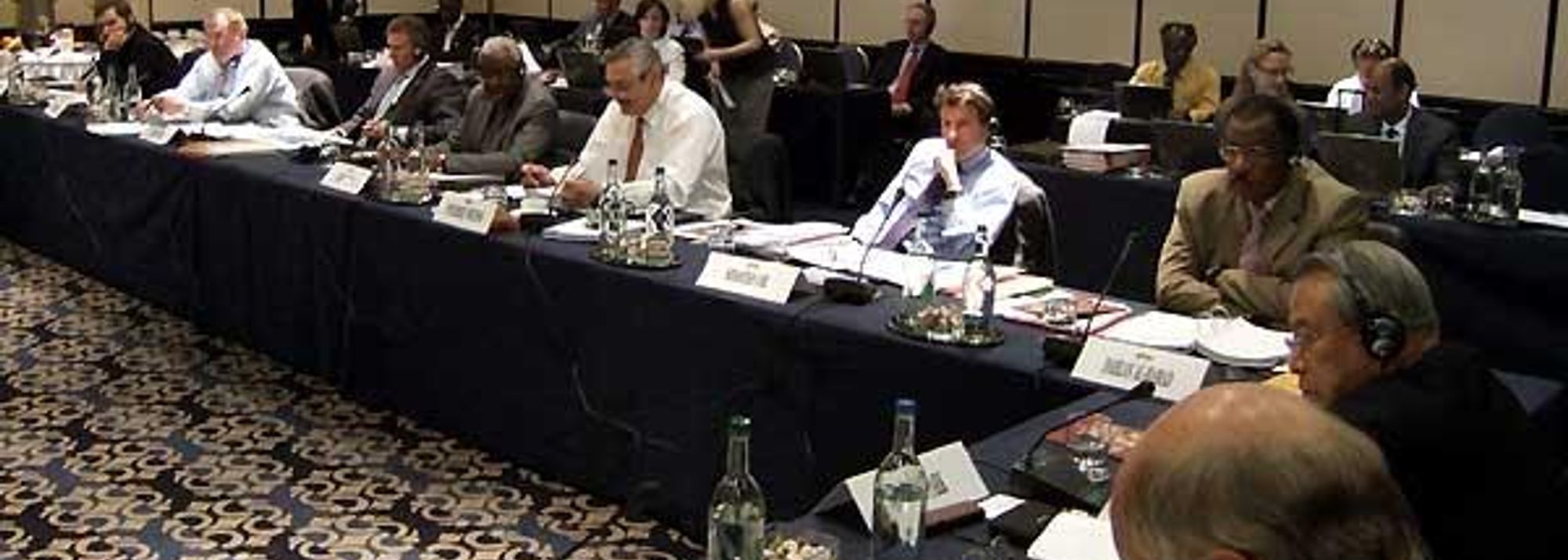IAAF Council, London - President Lamine Diack and Gen. Sec Pierre Weiss are flanked to the right by Hon. Treasurer Jean Poczobut, and Vice Presidents Bob Hersh and Sergey Bubka (senior) and to the left by Vice Presidents Seb Coe and Dahlan Jumaan Al Hamad (© Chris Turner for IAAF)
The hosting of the annual spring meeting of the IAAF Council in the next two days (1 to 2 April) at the Guoman Tower Hotel is the tenth time that the executive of the sport’s world governing body has met in the British capital since 1948 when London last held the Olympic Games.
It is also exactly 20 years, give or take a week, since the last of those gatherings in London on 15 / 16 April 1988.
The meeting marks a renewal of the historically close connections between London and the International Association of Athletics Federations (IAAF).
The second President of the IAAF, Britain’s Lord Burghley, 1932 Olympic 400m Hurdles champion, steered the association from 1946–1976 from the IAAF’s then London HQ. Current President Lamine Diack, the fifth to hold that stewardship, joined the Council for the first time in 1976 the year that Adriaan Paulen (the Netherlands) succeeded Burghley.
London, the long time home of the IAAF until the HQ’s move to Monaco on 17 October 1993, along with Britain as a whole has never been far away from the hub of world athletics in the years since the relocation.
The annual Super Grand Prix meeting in Crystal Palace brings the cream of track and field action to London each summer, while IAAF World Athletics Series events such as the World Indoor champs, World Cup of Athletics and World XC champs have found a warm and efficient welcome in these islands since the office’s departure to the south of France.
The Tower Hotel at which the Council meeting is being held, stands next to two icon London landmarks, Tower Bridge and the Tower of London, and is a location particularly relevant to London’s connection with the IAAF. The hotel is the long time HQ of the London marathon, annually one of the largest televised sporting events in the world let alone Britain with 30 to 40,000 runners and millions of spectators on the streets and viewers on TV.
In 1991, the hotel served as the nerve centre of the IAAF World Marathon Cup which combined with the annual city marathon presented a unique opportunity for members of the public to take part at a world championship level event running the same course with the world’s best runners.
It was a competition which created positive – in the best senses of the word – headlines for our sport in the world’s press.
In 2012, London will be hosting the Olympics for the third time following on from 1908 and 1948, opening another chapter in the city’s close bond with Athletics.
Before the introduction of the World Championships in Athletics in 1983, the Olympic Games were the IAAF’s designated World Championships, and of course the Games remain of the highest importance to our sport and in turn Athletics continues to be the Olympics number one attraction.
Its Olympic stadium, the 80,000 seat flagship venue for the 2012 Olympic and Paralympic Games, the site of whose construction the Council will visit on Thursday morning (3), will provide a legacy for our sport converting down to a 25,000 seat permanent stadium after the Games when it will become a new home for athletics, combined with other sporting, community and educational uses. For the elite end of our sport it is intended to give a 21st century state of the art location home for the London Super Grand Prix.
Chris Turner for the IAAF
All Council meetings held in London since 1948
April 2008
April 1988
January 1979
April 1976
April 1971
May 1969
April 1961
May 1955
August 1948
July 1948



